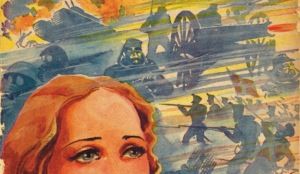Business & Education
Denmark’s Nostradamus was Fanny Enge, Schleswig’s guardian angel
This article is more than 9 years old.
The citizens of Southern Jutland found hope in many places during their long-standing conflict with Germany over sovereignty – not least in the pronouncements of a visionary maiden of unacknowledged royal blood

Fanny’s visions have been fictionalised on numerous occasions (photo: Saga)
The border between Denmark and Germany in the Schleswig region of Jutland seems to have gone up and down more times than a bride’s nightgown. For proud Danes in towns like Åbenraa, it was a neverending nightmare of submitting to German rule, sending their children to German schools and, at times, even being conscripted into the German army.
So when an unmarried seamstress in the town began having visions of a reunion with Denmark that subsequently became a reality, they gladly accepted her as the genuine article – and treasured her as their very own guardian angel.
Clue was in the name
The name of the seamstress name was Franziska Caroline Elise Enge, popularly known as Jomfru Fanny (Virgin Fanny), and she was born in the south Jutland town of Åbenraa on 31 August 1805, the illegitimate daughter of forest ranger Friedrich Enge and an unwed seamstress of low social standing, Christina Maria Margrethe Heise.
According to popular folklore, however, she was in fact the unacknowledged child of King Christian VIII and his fiancee Princess Charlotte Frederikke, so born out of wedlock and disowned – a rumour which would appear to be substantiated by the fact that a woman who worked all her life as seamstress and washerwoman without ever marrying managed to acquire a substantial private income, an impressive collection of silverware and owned her own home.
Crazier than Knud
Jomfru Fanny herself remained firmly silent nf the subject of any royal connection, living with her ‘mother’ Christina Heise until Heise’s death in 1853, when she moved into a small house on the outskirts of town she had purchased some 20 years earlier, where she remained alone with her visions and her embroidery until her own death in 1881.
The visions started after had a serious illness at the age of 27, but really took off in the following decades: she successfully predicted Denmark’s victory in the oft-times bloody ’Three Years’ War’ of 1848-1851, as well as the subsequent loss of the region back into the hands of Prussian Germany in 1864, but she firmly believed that Schleswig, and her home town of Åbenraa, would be returned to Danish rule – a premonition that kept alive hopes among her fellow townspeople.
She may have been the most hallucinatory Dane of her time, a wackier royal than Prince Knud, but one thing remains for certain: the citizens of her home town adored her and treasured her as their own personal prophet.
Fanny was right
Jomfru Fanny died on 27 March 1881, but her ghost was resurrected in 1920, when Schleswig’s reunion with Denmark, as predicted in her visions, became a reality. Suddenly, official plans started being reorganised to suit her predictions: troops took a more circuitous route when conducting operations in line with her posthumous advice, and the choice of a white horse for Christian X’s famous ride over the new border was made according to what she had ’seen.’
The ghost of Jomfru Fanny rose again during the Nazis’ rise to power over Germany and much of Europe, coinciding with the publication in 1933 of a small book about her life and visions. A symbolic force of hope during Denmark’s Occupation, Enge’s intricate embroidery work can still be seen in the town museum of Åbenraa.
A lightly fictionalised, very female take on her life became the framework for a novel in 1989 by writer Bodil Steensen-Leth, simply entitled ‘Jomfru Fanny’, bringing the allegedly royal spiritualist firmly into contemporary Danish folklore.










































